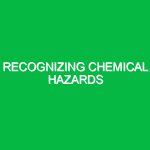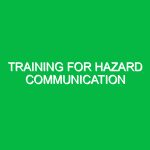Introduction
Waste disposal of hazardous chemicals is a critical issue that intersects environmental protection, public health, and workplace safety. In an era where industrial processes and consumer products often involve hazardous materials, understanding how to manage and dispose of these substances correctly is vital. Hazardous waste can come from various sources, including manufacturing processes, laboratories, medical facilities, and even households. The improper disposal of such materials can lead to severe environmental contamination, health risks for humans, and legal repercussions for businesses. This article aims to explore the intricacies of hazardous waste disposal within the Health, Safety, and Environment (HSE) domain, highlighting the associated risks, safety precautions, best practices, and regulatory frameworks.
Identifying Hazards and Risks
The first step in effective waste disposal of hazardous chemicals is identifying potential hazards and associated risks. Hazardous waste can take many forms, including corrosive, reactive, ignitable, and toxic substances. Each category presents unique challenges and dangers.
Types of Hazardous Waste
1. Corrosive Waste: This includes acids and bases that can cause severe damage to living tissue or materials. For instance, sulfuric acid, commonly used in batteries, can corrode containers and leach into the environment if not disposed of properly.
2. Reactive Waste: Materials that can undergo violent reactions when exposed to water or air fall into this category. An example would be sodium metal, which can ignite spontaneously in contact with moisture.
3. Ignitable Waste: These substances can easily catch fire and include solvents like paint thinners and gasoline. A vivid case comes from a local auto repair shop where improper disposal of used solvents led to a fire, causing extensive damage and health hazards.
4. Toxic Waste: Chemicals that are harmful or fatal when ingested or absorbed through the skin. Heavy metals like lead and mercury are prime examples, often found in electronic waste.
5. Biological Waste: Medical facilities produce hazardous waste that can be infectious, posing significant risks to public health. Sharps, blood-soaked materials, and cultures require specialized disposal methods.
Assessing Risks
Understanding the risks associated with these waste types is crucial. For businesses, failure to properly manage hazardous waste can result in legal penalties, financial losses, and damage to reputation. For individuals, improper disposal can lead to health hazards, such as respiratory issues or skin infections. In a study by the Environmental Protection Agency (EPA), improper hazardous waste management has been linked to numerous health problems, underscoring the importance of recognizing these risks.
Safety Precautions for Waste Disposal of Hazardous Chemicals
Implementing safety precautions is essential for mitigating risks associated with hazardous waste disposal. Here are several best practices that should be followed:
Personal Protective Equipment (PPE)
Wearing appropriate PPE is the first line of defense. Depending on the type of hazardous waste, workers might need gloves, goggles, face shields, or respiratory protection. For example, when handling corrosive materials, acid-resistant gloves and goggles can prevent chemical burns and eye injuries.
Proper Segregation
Segregating waste at the source can significantly reduce risks. Mixing different types of hazardous waste can lead to dangerous reactions. For instance, mixing organic solvents with acids can cause violent reactions. A case study from a chemical manufacturing facility showed that implementing a segregation system improved safety and compliance by 40%.
Labeling and Documentation
All hazardous waste should be clearly labeled with its contents and associated hazards. Documentation is crucial for tracking waste from the point of generation to its final disposal. This not only aids in compliance but also enhances safety by informing handlers about the risks involved.
Training and Awareness
Regular training programs for employees are vital. They should be educated about the types of hazardous waste they may encounter and the correct disposal methods. In my experience as a safety officer, I found that routine refresher courses significantly improved compliance and reduced incidents in the workplace.
Emergency Preparedness
Having an emergency response plan in place is essential. In the event of a spill or accidental release, workers must know how to respond quickly and effectively. This includes having spill kits readily available and conducting regular drills to ensure everyone is familiar with the procedures.
Best Practices for Hazardous Waste Disposal
Now, let’s delve into some best practices for the waste disposal of hazardous chemicals:
Utilization of Licensed Disposal Facilities
Always engage licensed hazardous waste disposal companies that comply with local, state, and federal regulations. These facilities possess the expertise and resources to handle hazardous materials safely. For example, a medical facility should not attempt to dispose of biohazardous waste independently but should rely on specialized services to mitigate risks.
Recycling and Recovery
Wherever possible, consider recycling or recovering materials. Many hazardous substances can be reused or repurposed. For instance, solvents can often be distilled and reused, significantly reducing waste generation and disposal costs. A manufacturing plant I consulted for reduced its hazardous waste by 30% through a solvent recovery program.
Adherence to Waste Minimization Principles
Implementing waste minimization strategies can significantly reduce the volume of hazardous waste generated. This may include modifying processes, substituting less hazardous materials, or optimizing inventory management to prevent excess waste.
Regulations and Standards Governing Hazardous Waste Disposal
Understanding the regulatory landscape is critical for compliance and safety. Several key regulations govern the waste disposal of hazardous chemicals:
The Resource Conservation and Recovery Act (RCRA)
Administered by the EPA, the RCRA provides a framework for managing hazardous waste. It establishes standards for waste treatment, storage, and disposal, ensuring that hazardous materials are handled in a manner that protects human health and the environment.
Occupational Safety and Health Administration (OSHA) Standards
OSHA outlines regulations that ensure workplace safety for employees handling hazardous materials. Compliance with OSHA standards means that employers must provide proper training, PPE, and safe handling procedures for hazardous chemicals.
Local and State Regulations
In addition to federal regulations, local and state laws may impose additional requirements. Businesses must stay informed about these regulations to avoid penalties and ensure community safety.
Conclusion
In summary, waste disposal of hazardous chemicals is a complex yet essential component of the Health, Safety, and Environment domain. By understanding the types of hazardous waste, implementing safety precautions, adhering to best practices, and complying with regulations, organizations can effectively manage hazardous waste. The stakes are high; improper disposal can lead to severe environmental harm and health risks. Thus, fostering a culture of safety and responsibility in waste disposal practices is crucial for protecting both people and the planet. As stewards of the environment, we must commit to responsible waste management, ensuring a safer future for all.


